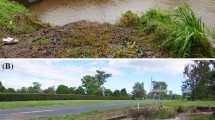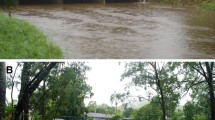Abstract
Low-level river crossings can have negative impacts on freshwater ecosystems, including blocking upstream fish passage. In order to restore upstream fish passage in culverts, we developed physically-based design methods to yield cost-effective culvert structures in order to maintain or restore waterway connectivity for a range of small-bodied fish species. New guidelines are proposed for fish-friendly multi-cell box culvert designs based upon two basic concepts: (1) the culvert design is optimised for fish passage for small to medium water discharges, and for flood capacity for larger discharges, and (2) low-velocity zones in the culvert barrel are defined in terms of a percentage of the wetted flow area where the local longitudinal velocity component is less than a characteristic fish speed linked to swimming performances of targeted fish species. This approach is novel and relies upon an accurate physically-based knowledge of the entire velocity field in the barrel, specifically the longitudinal velocity map, because fish tend to target low-velocity zone (LVZ) boundaries. The influence of the relative discharge threshold Q1/Qdes, characteristic fish swimming speed Ufish, and percentage of flow area on the size of box culvert structures was assessed. The results showed that the increase in culvert size and cost might become significant for a smooth culvert barrel with Ufish < 0.3 m/s and Q1/Qdes > 0.3, when providing 15% flow area with 0 < Vx < Ufish. Similar trends were seen for culvert barrel with recessed cell(s).






Similar content being viewed by others
References
Allen GR, Midgley SH, Allen M (2002) Field guide to the freshwater fishes of Australia. Western Australia Museum, Australia, p 394
Anderson GB, Freeman MC, Freeman BJ, Straight CA, Hagler MM, Peterson JT (2012) Dealing with uncertainty when assessing fish passage through culvert road crossings. Environ Manage 50:462–477
Bates K, Barnard B, Heiner B, Klavas JP, Powers PD (2003) Design of road culverts for fish passage. Washington Department of Fish and Wildlife, Washington, p 111
Behlke CE, Kane DL, Mcleen RF, Travis MT (1991) Fundamentals of Culvert Design for Passage of Weak-Swimming Fish. Report FHW A-AK-RD-90-10. Department of Transportation and Public Facilities, USA, p 178
Blank MD (2008). Advanced Studies of Fish Passage through Culverts: 1-D and 3-D Hydraulic Modelling of Velocity, Fish Energy Expenditure, and a New Barrier Assessment Method. Ph.D. thesis, Montana State University, Department of Civil Engineering, Bozeman, Montana, USA, p 231
Briggs AS, Galarowicz TL (2013) Fish passage through culverts in central michigan warmwater streams. N Am J Fish Manage 33:652–664
Cabonce J, Fernando R, Wang H, Chanson H (2017) Using Triangular Baffles to Facilitate Upstream Fish Passage in Box Culverts: Physical Modelling. Hydraulic Model Report No. CH107/17. School of Civil Engineering, The University of Queensland, Brisbane, Australia, p 130
Cabonce J, Fernando R, Wang H, Chanson H (2019) Using small triangular baffles to facilitate upstream fish passage in standard box culverts Environ Fluid Mech 19(1):157–179. https://doi.org/10.1007/s10652-018-9604-x
Cabonce J, Wang H, Chanson H (2018) Ventilated corner baffles to assist upstream passage of small-bodied fish in box culverts. J Irri Drain Engg 144(8):Paper 0418020. https://doi.org/10.1061/(ASCE)IR.1943-4774.0001329)
Cahoon JE, Mcmahon T, Solcz A, Blank M, Stein O (2007) Fish Passage in Montana Culverts: Phase II - Passage Goals. Report FHWA/MT-07-010/8181, Montana Department of Transportation and US Department of Transportation, Federal Highway Administration, Bozeman, Montana, USA
Chanson H (1999) Culvert Design. In: Chanson H (ed.) The Hydraulics of Open Channel Flow: An Introduction, 1st edn. Butterworth-Heinemann, UK, p 365–401
Chanson H (2000) Introducing originality and innovation in engineering teaching: the hydraulic design of culverts. Euro J Engg Edu 25(4):377–391
Chanson H (2004) The Hydraulics of Open Channel Flow: An Introduction, 2nd edn. Butterworth-Heinemann, Oxford, p 630
Chanson H, Leng X (2018) On the Development of Hydraulic Engineering Guidelines for Fish-Friendly Standard Box Culverts, with a Focus on Small-Body Fish. Civil Engineering Research Bulletin No. 25. School of Civil Engineering, The University of Queensland, Brisbane, p 79
Chorda J, Larinier M, Font S (1995) Le Franchissement par les Poissons Migrateurs des Buses et Autres Ouvrages de Rétablissement des Ecoulements Naturels lors des Aménagements Routiers et Autoroutes. Etude Expérimentale. Rapport HYDRE n°159 - GHAAPPE n°95-03. Groupe d’Hydraulique Appliquée aux Aménagements Piscicoles et à la Protection de l’Environnement, Service d’Etudes Techniques des Routes et Autoroutes, Toulouse, p 116
Concrete Pipe Association of Australasia (1991) Hydraulics of Precast Concrete Conduits, 3rd edn. Jenkin Buxton Printers, Australia, p 72
Concrete Pipe Association of Australasia (2012) Hydraulics of Precast Concrete Conduits. CPAA Design Manual, Australia, p 64
Courret D (2014) Petits Ouvrages Hydrauliques et continuite pisicole. Equipement des OH existants: principes de choix et de dimensionnement des dispositifes.” Presentation, Nancy
DWA (2014) Fischaufstiegsanlagen und fischpassierbare Bauwerke – Gestaltung, Bemessung, Qualitätssicherung. Merkblatt DWA-M 509, Deutsche Vereinigung für Wasserwirtschaft, Abwasser und Abfall e. V., Hennef, Germany, p 334
DPI-Fisheries (2013). Policy and Guidelines for Fish Habitat Conservation and Management. NSW Department of Primary Industries, Wollongbar, NSW, Australia, p 80
Dynesius M, Nilsson C (1994) Fragmentation and flow regulation of river systems in the northern third of the world. Science 266:753–762
Fairfull S, Witheridge G (2003) Why do fish need to cross the road? Fish passage requirements for waterway crossings. NSW Fisheries, Cronulla NSW, p 14
Gardner A (2006) Fish Passage through Road Culverts. North Carolina State University, USA, p 103. Master of Science thesis
Goodrich HR, Watson JR, Cramp RL, Gordos M, Franklin CE (2018) Making culverts great again. Efficacy of a common culvert remediation strategy across sympatric fish species. Ecological Eng. 116:143–153
Hee M (1969) Hydraulics of Culvert Design Including Constant Energy Concept. Proc. 20th Conf. of Local Authority Engineers, Dept. of Local Govt, Queensland, paper 9, pp 1–27
Henderson FM (1966) Open Channel Flow. MacMillan Company, New York
Herr LA, Bossy HG (1965) Capacity Charts for the Hydraulic Design of Highway Culverts. Hydraulic Eng Circular, US Dept. of Transportation, Federal Highway Admin, HEC No. 10, March
Hotchkiss RH, Frei CM (2007) Design for Fish Passage at Roadway-Stream Crossings: Synthesis Report.” Publication No. FHWA-HIF-07-033, Federal Highway Administration, US Department of Transportation, p 280
Hunt M, Clark S, Tkach R (2012) Velocity distributions near the inlet of corrugated steep pipe culverts. Canad J Civil Engg 39:1243–1251
Hurst TP, Kay BH, Ryan PA, Brown MD (2007) Sublethal effects of mosquito larvicides on swimming performances of larvivorous fish Melanotaenia duboulayi (Atheriniformes: Melanotaeniidae). J Econ Entomol 100(1):61–65
Jensen KM (2014) Velocity Reduction Factors in Near Boundary Flow and the Effect on Fish Passage Through Culverts. Brigham Young University, USA, p 44
Kapitzke IR (2010) Culvert Fishway Planning and Design Guidelines. Report. James Cook University, Townsville, version 2.0
Katopodis C, Gervais R (2016) Fish Swimming Performance Database and Analyses. DFO CSAS Research Document No. 2016/002. Canadian Science Advisory Secretariat, Fisheries and Oceans Canada, Ottawa, p 550
Kemp P (2012) Bridging the gap between fish behaviour, performance and hydrodynamics: an ecohydraulics approach to fish passage research. River Res Appl 28:403–406. https://doi.org/10.1002/rra.1599
Koehn JD, Crook DA (2013) Movements and migration. In: Humphries P, Walker K (eds) Ecology of Australian Freshwater Fishes. CSIRO Publishing, Australia, pp 105–130
Khodier MA, Tullis BP (2017) Experimental and computational comparison of baffled-culvert hydrodynamics for fish passage. J Appl Water Engg Res 6(3):191–199. https://doi.org/10.1080/23249676.2017.1287018
Kilgore RT, Bergendahl BS, Hotchkiss RH (2010) Culvert Design for Aquatic Passage. Hydraulic Engineering Circular Number No. 26, Federal Highway Administration Publication No. FHWA-HIF-11-008, p 234
Larinier M (2002) Fish Passage through Culverts, Rock Weirs and Estuarine Obstructions. Bulletin Français de Pêche et Pisciculture 364(Supplement):119–134
Lintermans M (2013) Recovering threatened freshwater fish in Australia. Marine Freshwater Res 64:iii–vi. https://doi.org/10.1071/MFv64n9_IN
Maddock I, Harby A, Kemp P, Wood P (2013) Research Needs, Challenges and the Future of Ecohydraulics Research. In: I Maddock, A Harby, P Kemp and P Wood (eds) Ecohydraulics: An Integrated Approach, John Wiley, pp 431–436
Mallen-Cooper M (1996) Fishways and Freshwater Fish Migration in South-Eastern Australia. Ph.D. thesis. University of Technology Sydney, Australia, p 442
Milt AW, Diebel MW, Doran PJ, Ferris MC, Herbert M, Khoury ML, Moody AT, Neeson TM, Ross J, Treska T, O’hanley JR, Walter L, Wangen AR, Yacobson E, Mcintyre PB (2018) Minimizing opportunity costs to aquatic connectivity restoration while controlling an invasive species. Conserv Biol 32(4):894–904. https://doi.org/10.1111/cobi.13105
Monk SK, Hotchkiss RH (2012) Culvert Roughness Elements for Native Utah Fish Passage: Phase II. Report No. UT-12.09. Utah Department of Transportation—Research Division, USA, p 47
Morvan H, Knight D, Wright N, Tang X, Crossley A (2008) The concept of roughness in fluvial hydraulics and its formulation in 1D, 2D and 3D numerical simulation models. J Hydraul Res 46(2):191–208
Oberkampf WL, Trucano TG, Hirsch C (2004) Verification, validation, and predictive capability in computational engineering and physics. Appl Mech Rev 57(5):345–384
O’Hanley JR (2011) Open rivers: barrier removal planning and the restoration of free-flowing rivers. J Environ Manage 92:3112–3120
Olsen A, Tullis B (2013) Laboratory study of fish passage and discharge capacity in slip-lined, baffled culverts. J Hydraul Engg 139(4):424–432
Olson LJ, Roy S (2002) The economics of controlling a stochastic biological invasion. Am J Agric Econ 84:1311–1316
Papanicolaou AN, Talebbeydokhti N (2002) Discussion of “Turbulent open-channel flow in circular corrugated culverts. J Hydraul Engg 128(5):548–549
QUDM (2013) Queensland Urban Drainage Manual, 3rd edn. Queensland Department of Energy and Water Supply, Brisbane, p 459
Rizzi A, Vos J (1998) Toward establishing credibility in computational fluid dynamics simulations. AIAA J 36(5):668–675
Roache RL (1998) Verification and Validation in Computational Science and Engineering. Hermosa Publishers, Albuquerque NM, p 446
Rodi W (2017) Turbulence modeling and simulation in hydraulics: a historical review. J Hydraul Engg 143(5):Paper03117001. https://doi.org/10.1061/(ASCE)HY.1943-7900.0001288
Rodi W, Constantinescu G, Stoesser T (2013) Large-Eddy Simulation in Hydraulics. IAHR Monograph, CRC Press, Taylor & Francis Group, Leiden, p 252
Schall JD, Thompson PL, Zerges SM, Kilgore RT, and Morris JL (2012) Hydraulic Design of Highway Culverts. Hydraulic Design Series No. 5, Federal Highway Administration, Publication No. FHWA-HIF-12-026, 3rd edn, Washington, DC, USA, p 326
Wang H, Chanson H (2018) Modelling upstream fish passage in standard box culverts: interplay between turbulence, fish kinematics, and energetics. River Res Appl 34(3):244–252. https://doi.org/10.1002/rra.3245
Wang H, Chanson H, Kern P, Franklin C (2016a) Culvert Hydrodynamics to enhance Upstream Fish Passage: Fish Response to Turbulence. Proceedings of 20th Australasian Fluid Mechanics Conference, Australasian Fluid Mechanics Society, G. Ivey, T. Zhou, N. Jones, S. Draper Editors, Perth WA, 5–8 December, p 682
Wang H, Beckingham LK, Johnson CZ, Kiri UR, Chanson H (2016b) “Interactions between Large Boundary Roughness and High Inflow Turbulence in Open channel: a Physical Study into Turbulence Properties to Enhance Upstream Fish Migration.” Hydraulic Model Report No. CH103/16. School of Civil Engineering, The University of Queensland, Brisbane, p 74
Warren Jr. ML, Pardew MG (1998) Road crossings as barriers to small-stream fish movement. Trans Am Fish Soc 127:637–644
Wilkes MA, Webb JA, Pompeu PS, Silva LGM, Vowles AS, Baker CF, Franklin P, Link O, Habit E, Kemp PS (2018) Not just a migration problem: Metapopulations, habitat shifts, and gene flow are also important for fishway science and management. River Res Appl https://doi.org/10.1002/rra.3320
Zhang G, Chanson H (2018) Three‐dimensional numerical simulations of smooth, asymmetrically roughened, and baffled culverts for upstream passage of small‐bodied fish. River Res Appl 34(8):957–964. https://doi.org/10.1002/rra.3346
Acknowledgements
The authors thank Professor Colin J. APELT (The University of Queensland, Australia), Dr Gangfu ZHANG (WSP Brisbane, Australia), and Professor Daniel BUNG (FH Aachen University of Applied Science, Germany) for valuable comments. Further comments from discussions with a number of professional engineers and biologists were considered.
Funding
The financial support of Australian Research Council (Grant LP140100225) is acknowledged.
Author information
Authors and Affiliations
Corresponding author
Ethics declarations
Conflict of Interest
The authors declare that they have no conflict of interest.
Additional information
Publisher’s note: Springer Nature remains neutral with regard to jurisdictional claims in published maps and institutional affiliations.
Supplementary information
Rights and permissions
About this article
Cite this article
Leng, X., Chanson, H., Gordos, M. et al. Developing Cost-Effective Design Guidelines for Fish-Friendly Box Culverts, with a Focus on Small Fish. Environmental Management 63, 747–758 (2019). https://doi.org/10.1007/s00267-019-01167-6
Received:
Accepted:
Published:
Issue Date:
DOI: https://doi.org/10.1007/s00267-019-01167-6




